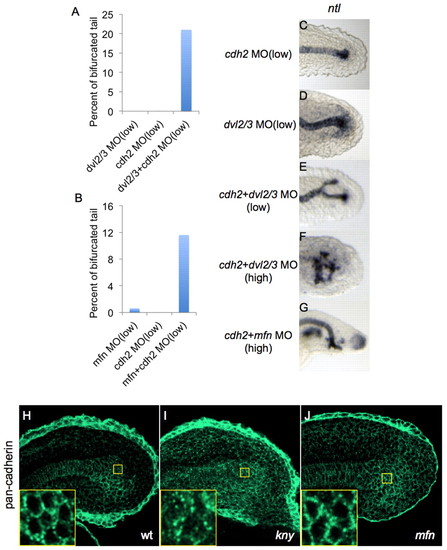
N-cadherin is required to maintain tailbud integrity. (A,B) Percentages of bifurcated tail in zebrafish embryos injected with the indicated combination of morpholinos (MOs). For low concentrations, dvl2/3 (1 mg/ml each), mfn (0.5 mg/ml) and chd2 (0.1 mg/ml) MOs were injected. For each column over 100 embryos from three separate experiments were scored. (C-G) Lateral view of tails of embryos at 24 hpf injected with the indicated combination of morpholinos, after in situ hybridization for ntl. ntl expression in cdh2 and dvl2/3 MO morphants (C,D) is similar to wild type. Note that co-injection of a high concentration of chd2 and dvl2/3 MOs further enhanced the ntl expression from a single fork shaped pattern (E) to a multi-fork pattern (F), but co-injection of high concentration of chd2 and mfn MOs (G) did not result in a similar phenotype. This difference is consistent with the following antibody staining results (see below). For high concentrations, dvl2/3 (1.5 mg/ml each), mfn (1.5 mg/ml) and chd2 (0.25 mg/ml) MOs were injected. (H-J) Representative confocal microscopy images of tailbud in wild-type, kny and mfn embryos stained with pan-cadherin antibody at 21 somites; inset, close-up of the caudal end of notochord. Membrane staining pattern in the caudal end of notochord is shown in the wild type (H) and the mfn (J) mutant, whereas diffused staining pattern is shown in the kny mutant (I).
|

